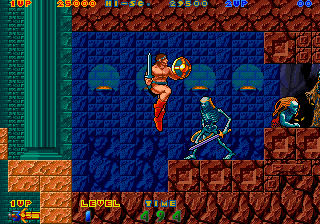Rastan was a classic late 80s arcade hit for Taito. Somehow this sequel didn't turn out so well. Possibly the only thing saving it from a worse reputation than it already has is that it isn't well-known at all. The game's design is credited to Hisaya Yabusaki, whose only other design credit is for Taito's animal conservation-themed brawler Growl.
The game's attract mode lays out the story in classic Engrish: The "Rastania" was a sacred place, in which the sacred temple, "Skycraper", soared into the sky. It is said that whoever conquer the "Skyscraper" would rule the "Rastania". A wicked group has invaded the "Skyscraper" and has tried to make it their own. If the situation is left as it is, the place would eventually be controlled by the wicked group.
The player controls a headstrong warrior who seeks to defeat the "wicked group" occupying the tower, although the settings for the five levels don't bother with internal consistency very much. You'll go from looking over tree tops, to a cavern, to a forest, etc. The characters are bigger than the sprites in Rastan, but the game is slower and feels much clumsier to control. Actions like the downward stab that were easy to execute in Rastan now require precise timing - if you do the downward attack too soon the warrior will revert back to his regular stance before coming down on the enemy and will take damage. Even grabbing and leaping off Taito's classic swinging ropes can be oddly finicky. Even worse, the game takes advantage of this and will force the player to deal with incredibly difficult jumps or fall to his death in bottomless pits. One particular trap involves having to do a weird mid-air crouch while falling to squeeze into a tiny space - moves like this have to literally be pixel-perfect in execution. It feels cheap instead of challenging.
Probably the most noteworthy difference from Rastan in gameplay is that the player can block attacks when not attacking. The hero starts with a short sword and shield and can also obtain a long two-handed sword or a pair of iron clawed gauntlets that have shorter range but more power.
Between levels, the game treats the player to scenes of the hero commenting on the action; e.g., clearing level 2 gives a closeup of him with the claw weapon, declaring, "You wicked people! How did you like my assault? Oh, here come tough enemies!" One can imagine how this would sound appropriately badass with a proper translation - maybe something like "You bastards! You like the taste of my steel? Come and get some more!" - but good Japanese-to-English translations even today can't always be taken for granted. At least the music is still pretty good, although not as immediately memorable as the original's.






No comments:
Post a Comment